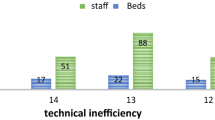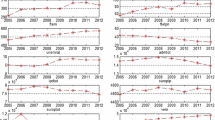Abstract
The health care sector is one of the fastest growing sectors in the United States. Researchers are interested in conducting studies in the area of health economics in order to propose solutions to curb the rapid increase in health care spending and to improve the efficiency of the health care system in the United States. Specifically, hospital efficiency is one important research area in health economics. In this paper, data envelopment analysis (DEA) is used to assess hospital efficiency. An additive super-efficiency model is presented and applied to a sample of general acute care hospitals in Pennsylvania. In addition to the conventional choice of input and output variables, we include the survival rate as a quality measure of health outcome in the set of output variables. Thus our model takes both the quantity and the quality of the output into account. With the results obtained from our proposed DEA model, inefficiencies can be identified for hospitals to address without sacrificing the quality of care.
Similar content being viewed by others
References
Charnes, A., Cooper, W. W., & Rhodes, E. (1978). Measuring the efficiency of decision making units. European Journal of Operational Research, 2, 429–444.
Charnes, A., Cooper, W. W., Seiford, L. M., & Stutz, J. (1982). A multiplicative model for efficiency analysis. Socio-Economic Planning Sciences, 16(5), 223–224.
Cooper, W. W., Seiford, L. M., & Zhu, J. (2004). Handbook on data envelopment analysis. Boston: Springer.
Du, J., Liang, L., & Zhu, J. (2010). A slacks-based measure of super-efficiency in data envelopment analysis: a comment. European Journal of Operational Research, 204, 694–697.
Ferrier, G. D., & Valdmanis, V. (2004). Do mergers improve hospital productivity? Journal of the Operational Research Society, 55(10), 1071–1080.
Grosskopf, S., Margaritis, D., & Valdmanis, V. (2001). The effects of teaching on hospital productivity. Socio-Economic Planning Sciences, 35(3), 189–204.
Grosskopf, S., Margaritis, D., & Valdmanis, V. (2004). Competitive effects on teaching hospitals. European Journal of Operational Research, 154(2), 515–525.
Harris, J. M., Ozgen, H., & Ozcan, Y. A. (2000). Do mergers enhance the performance of hospital efficiency? Journal of the Operational Research Society, 51, 801–811.
Harrison, J. P., & Sexton, C. (2006). The improving efficiency frontier of religious not-for-profit hospitals. Hospital Topics, 84(1), 2–10.
Harrison, J. P., Coppola, M. N., & Wakefield, M. (2004). Efficiency of federal hospitals in the United States. Journal of Medical Systems, 28(5), 411–422.
Hollingsworth, B., Dawson, P. J., & Maniadakis, N. (1999). Efficiency measurement of health care: a review of non-parametric methods and applications. Health Care Management Science, 2(3), 161–172.
Lee, K., & Wan, T. T. H. (2004). Information system integration and technical efficiency in urban hospitals. International Journal of Healthcare Technology and Management, 1(3/4), 452.
O’Neill, L. (1998). Multifactor efficiency in data envelopment analysis with an application to urban hospitals. Health Care Management Science, 1(1), 19–27.
Sherman, H. D. (1984). Hospital efficiency measurement and evaluation: empirical test of a new technique. Medical Care, 22(10), 922–938.
Sisko, A., Truffer, C., Smith, S., Keehan, S., Cylus, J., Poisal, A. J., Clemens, M. K., & Lizonitz, J. (2009). Health spending projections through 2018: Recession effects add uncertainty to the outlook. Health Affairs, 28(2), 346–357.
Sloan, F. A., Feldman, R. D., & Steinwald, B. (1983). Effects of teaching on hospital costs. Journal of Health Economics, 2, 1–28.
Sloan, F. A., & Valvona, J. (1986). Uncovering the high cost of teaching hospitals. Health Affairs, 5(3), 68–85.
Author information
Authors and Affiliations
Corresponding author
Rights and permissions
About this article
Cite this article
Du, J., Wang, J., Chen, Y. et al. Incorporating health outcomes in Pennsylvania hospital efficiency: an additive super-efficiency DEA approach. Ann Oper Res 221, 161–172 (2014). https://doi.org/10.1007/s10479-011-0838-y
Published:
Issue Date:
DOI: https://doi.org/10.1007/s10479-011-0838-y




